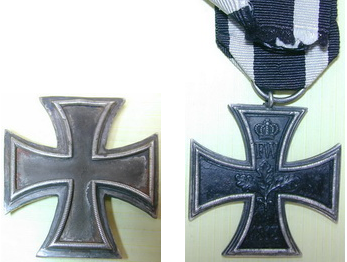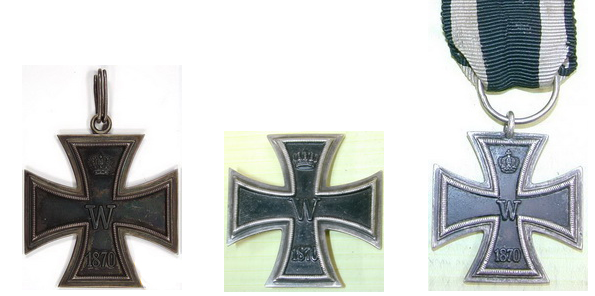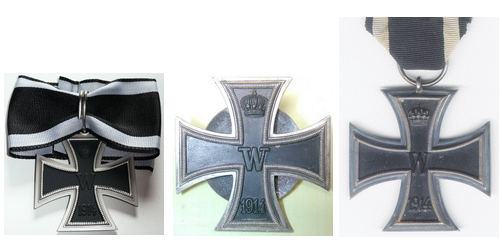The German Iron Cross guide
The German Iron Cross is one of the most important military orders, here is a detailed guide about the various Iron Cross types.
Origin or the German Iron Cross
The Iron Cross was conceived and designed in 1813 by Karl Friedrich Schinkel, one of the most famous architects of his time in Prussia. The decoration consists of four symmetrical flared points and is directly inspired by the emblem of the Teutonic knights. The origin of the symbolism of the decoration also lies in a statue placed in 1793 above the Brandenburg Gate in Berlin. This quadrigas depicts the goddess of Victory on a chariot drawn by four horses. In 1806, the quadrigue was taken by Napoleon I's army who wanted to install it in Paris. At the fall of Napoleon I, the quadrige was found in Paris and put back in its place in Berlin. An Iron Cross was substituted for the laurels.
Based on the model of the "Légion d'Honneur" created by Napoleon, the Iron Cross was the second European military merit decoration awarded without distinction of rank or social category, which contributed to its popularity.
The Iron Cross of 1813
The Iron Cross was established on March 10, 1813 during the reign of Kaiser Frederick William III of Prussia and awarded as the highest military decoration during the war against Napoleon Bonaparte's First French Empire (cf. Stiftung durch König Friedrich Wilhelm III. von Preußen).
The Iron Cross of 1813 is declined in 3 orders:
-The Great Cross of the Iron Cross (Grosskreuz),
- The Iron Cross 1st class, with a clasp (Eiserne Kreuz I),
-The Iron Cross 2nd class, with a ribbon (Eiserne Kreuz II).

1813 Iron Cross 1st and 2nd class
The Iron Cross 1st class is a simple cross without inscriptions, the Iron Cross 2nd class is decorated with oak leaves in the center, the number "1813" in the bottom and the initials of Frederick William (FW) surmounted by a crown in the top. Nothing is inscribed on the back of the two crosses. For non-combatants the Iron Cross is worn with a white ribbon.
On July 26, 1815, Field Marshal Gebhard Lebrecht Fürst Blücher von Wahlstatt was awarded, for his outstanding merits at the Battle of Waterloo, a Cross of a class not originally intended and known as the Star of the Great Cross of the Order of the Iron Cross (Stern des Großkreuzes des Eisernen Kreuzes) or Blücherstern ("Blücher's Star"). This decoration consisted of an Iron Cross 1st class fixed on a golden eight-pointed star.
The number of Iron Crosses awarded between 1813 - 1815 and for an army of 271,000 men is estimated at :
- approx. 15,439 for the Second Class Cross (4,595 officers, 10,844 soldiers),
- approx. 668 for the First Class Cross.
- 5 Great Cross :
.Field Marshal Gebhard Lebrecht von Blücher (31 August 1813),
.Friedrich Wilhelm Bülow von Dennewitz (15 September 1813),
.Kronprinz Karl Johann von Schweden (1813),
.Bogislav Friedrich Emanuel von Tauentzien (26 January 1814),
.Johann David Ludwig Graf Yorck von Wartenburg (31 March 1814),
-1 Stern des Großkreuzes des Eisernen Kreuzes to Marshal Gebhard Lebrecht Fürst Blücher von Wahlstatt (July 26, 1815).
The Iron Cross of 1870
The Iron Cross was first re-established on July 19, 1870 by Kaiser Wilhelm I of Prussia during the Franco-Prussian War to reward the military bravery of the armies of all German states (cf. Erneuerung durch König Wilhelm I. von Preußen).
The Iron Cross of 1870 is declined in 3 orders:
- The Great Cross of the Iron Cross (Grosskreuz),
- The Iron Cross 1st class, with a clasp (Eiserne Kreuz I),
- The Iron Cross 2nd class, with a ribbon (Eiserne Kreuz II).

1870 Great Cross | Iron Cross 1st class | Iron Cross 2nd class
The pattern of the Iron Cross 1st and 2nd class is the same. On the front, they are decorated with a crown in the top, the number "1870" in the bottom and a "W" for William (Wilhelm in German). On the back, the Iron Cross 2nd class is decorated with oak leaves in the center and the number "1813" at the bottom.
For non-combatants the Iron Cross is worn with a white ribbon.
In 1895, for the 25th anniversary of the War of 1870, a number of Iron Cross 2nd class veterans will receive oak leaves bearing the number 25.
As for the number of Iron Crosses of 1870 awarded between 1870 - 1871 and for an army of 600,000 men, it is estimated that:
- approx. 43,242 for the 2nd class Cross,
- approx. 1.319 for the First Class Cross,
- 9 Great Cross :
.Crowned Prince Albert of Saxony (March 22, 1871),
.August Karl von Goeben (22 March 1871),
.Edwin Freiherr von Manteuffel (22 March 1871),
.Helmuth Graf von Moltke (22 March 1871),
.Prince Frederick Charles of Prussia (March 22, 1871),
.Crowned Prince Friedrich Wilhelm of Prussia, the future Kaiser Friedrich III (March 22, 1871),
.August Graf von Werder (22 March 1871),
.Kaiser Wilhelm I (June 16, 1871),
.Friedrich Franz II, Grand Duke of Mecklenburg-Schwerin (December 4, 1871).
The Iron Cross of 1914
The Iron Cross was restored a second time on 5 August 1914 by Kaiser Wilhelm II during the First World War (see Erneuerung durch König Wilhelm II. von Preußen ).
The Iron Cross of 1914 is declined in 3 orders:
-The Great Cross of the Iron Cross (Grosskreuz),
- The Iron Cross 1st class, with a clasp (Eiserne Kreuz I),
- The Iron Cross 2nd class, with a ribbon (Eiserne Kreuz II).

WW1 Great Cross | Iron Cross 1st class | Iron Cross 2nd class
On March 24, 1918, Field Marshal Paul von Hindenburg und Beneckendorff received the Star of the Great Cross of the Order of the Iron Cross (Stern des Großkreuzes des Eisernen Kreuzes) or Hindenburgstern. There will be only two recipients of this outstanding decoration.
The pattern of the Iron Crosses 1st and 2nd class is the same. On the front they are decorated with a crown in the upper part, the number "1914" in the lower part and a "W" for William (Wilhelm in German). On the back, the Iron Cross 2nd class is decorated with oak leaves in the center and the number "1813" at the bottom. For non-combatants, the colors of the ribbon are reversed.
For former recipients of the Iron Crosses of 1870 and who are awarded the Iron Cross of 1914, a reminder badge (spange) is worn on the original decoration.
As for the number of Iron Crosses of 1914 awarded between 1914 and 1918 and for an army of 13,400,000 men, it is estimated that the number of :
- approx. 5,215,855 for the 2nd class Cross, i.e. :
.5,196,000 for acts of war,
.13,000 in civil matters,
.6,855 for services rendered to the fatherland.
-approx. 218,000 for the First Class Cross,
- 5 Great Cross:
.Field Marshal Paul von Hindenburg und Beneckendorff (9 December 1916),
.Kaiser Wilhelm II (December 11, 1916),
.Marshal August von Mackensen (9 January 1917),
.Marshal Prince Leopold of Bavaria (March 4, 1918),
.General Erich Ludendorff (March 24, 1918).
- 1 Stern des Großkreuzes des Eisernen Kreuzes to Marshal Paul von Hindenburg und Beneckendorff (24 March 1918).
The Iron Cross of 1939
The Iron Cross was re-established a third time on 1 September 1939 by Adolf Hitler during the Second World War (cf. Reichsgesetzblatt Teil I S. 1573).
The Iron Cross of 1939 is then declined in 4 orders:
- The Great Cross of the Iron Cross (Grosskreuz des Eisernen Kreuzes),
- The Iron Cross Knight's Cross (Ritterkreuz des Eisernen Kreuzes),
- The Iron Cross 1st class (Eiserne Kreuz 1. Klasse),
- The Iron Cross 2nd class (Eiserne Kreuz 2. Klasse).
For former recipients of the Iron Crosses of 1914 and who are awarded the Iron Cross of 1939, a reminder badge (spange) is worn on the original decoration :
-The staple of the Iron Cross 1st class of 1914 (Spange zum Eiserne Kreuz 1. Klasse),
-The clip of the Iron Cross second class of 1914 (Spange zum Eiserne Kreuz 2. Klasse).
A law of the 3rd June 1940 (cf. Reichsgesetzblatt Teil I S. 849 ) added the Iron Cross knight's Cross with oak leaf (Ritterkreuz des Eisernen Kreuzes mit Eichenlaub) to the orders.
WW2 Iron Cross
Presentation of the various orders of the Iron Cross of 1939 in accordance with the law of June 3, 1940 (Signal, number 15 of 1940). Above: the Great Cross of the Order of the Iron Cross. In the middle on the left: The Iron Cross Knight's Cross with oak leaf. In the middle right: The Knight Cross of the Iron Cross. Bottom left: The clasp of the Iron Cross second class of 1914. In the middle below: The Iron Cross 1st class with above the staple of the Iron Cross 1st class of 1914. Bottom right: The Iron Cross second class.
To reward the very first recipients of the Iron Cross Knight's Cross following the Polish and then French campaigns, Hitler will organize a ceremony where he will give the great commanders of the armies a box containing the three orders of the Iron Cross. It is the company Gebrüder Godet & Co of Berlin who made the boxes.
Later on, other crosses have been added :
-The Iron Cross Knight's Cross with oak leaves and swords, (Ritterkreuz des Eisernen Kreuzes mit dem Eichenlaub mit Schwertern) and the Knight's Cross with oak leaves, swords and brilliants, on September 28, 1941 (cf. Reichsgesetzblatt Teil I S. 613 ),
-On December 29, 1944 (cf. Reichsgesetzblatt 1945 I S. 11), the Knight's Cross with oak leaves and gold and brilliant swords, (Ritterkreuz des Eisernen Kreuzes mit dem Goldenen Eichenlaub mit Schwertern und Brillanten).
Knight's cross with oak leaves and gold and brilliant swords
-After the war and Germany's victory, Hitler's plan was to make the Star of the Great Cross of the Order of the Iron Cross (Stern des Großkreuzes des Eisernen Kreuzes) on the same principle as the Blücherstern.
For all the crosses, on the recto, is the swastika in the center and the number 1939 at the bottom. On the reverse side, the year 1813 is shown at the bottom. The ribbon is now in the colors of the Reich, black, white and red. The design of the new crosses is the work of Emil Escher, an engraver employed by the Ludenscheid firm Steinhauer und Lück.
The number of Iron Crosses awarded between 1939 - 1945 and for an army of 18,000,000 men is estimated at :
-approx. 3.000.000 for the 2nd class Cross (including 39 women, mainly nurses),
-approx. 450,000 for the 1st class cross (only one woman, the Flugkapitän Hanna Reitsch),
-approx. 100.000 Iron Cross stamps of the Iron Cross 1st class and 2nd class of 1914,
-7,361 for the Knight's Cross, 43 of which were non-German (see List of recipients). As a reminder, there were three recipients of the French Knight's Cross on April 29, 1945, in the ruins of Berlin, all of them from the 33. SS-Freiw.Gren.Div. "Charlemagne" :
.The SS-Uscha Eugène "Gégène" Vaulot (1923 - 1945?), from the hands of the SS-Brig.Fhr. Krukenberg at his PC at the "Stadtmitte" subway station. He is said to have died on the night of May 1 or 2 while trying to leave Berlin,
.The SS-Oscha. Robert Appolot (? - 1945 ?). He would have died on 1 May,
.The SS-Hsuf. Henri-Joseph Fénêt (1919 - 2002) who will only learn about it after the war.
-890 for the Knight's Cross with oak leaves, 8 of which were non-German (cf. List of recipients),
-160 for the Knight's Cross with oak leaves and swords, including 1 non-German (see list of recipients),
-27 for the Knight's Cross with oak leaves, swords and shingles (see List of Recipients),
-1 for the Knight's Cross with oak leaves, gold swords and brilliants (Hans-Ulrich Rudel, December 29, 1944),
-1 for the Grand'croix (Hermann Göring, 19 July 1940).
The Iron Cross of 1957
With the re-creation of the German army (Bundeswehr) on November 2, 1955, many former soldiers found themselves back in uniform. Among them, 780 are former Knights of the Iron Cross, 114 of whom have the rank of General .
A law of 26 July 1957 then authorized the wearing of former decorations on condition that they were denazified (cf. Gesetz über Titel, Orden und Ehrenzeichen).
The Iron Cross of 1957 partly resumes the orders of 1939:
-The Iron Cross Knight's Cross with oak leaves and swords (Ritterkreuz des Eiserne Kreuz mit Eichenlaub und Schwertern),
-The Iron Cross Knight's Cross with oak leaf (Ritterkreuz des Eiserne Kreuz mit Eichenlaub),
-The Iron Cross Knight's Cross (Ritterkreuz des Eiserne Kreuz),
-The Iron Cross 1st class (Eiserne Kreuz 1. Klasse),
-The Iron Cross 2nd class (Eiserne Kreuz 2. Klasse)
-The Stamp of the Cross
1957 Bundeswehr Iron Cross
This Iron Cross has the oak leaves of the 1813 model in the center, but with the year "1939" at the bottom. The ribbon remains black, white and red.
The Iron Cross being a war period decoration, none has been awarded since May 11, 1945. The last recipient of the Iron Cross will be the Oberleutnant zur See Wolfgang Feller of the 36. Minensuchflottille on June 17, 1945, but never received his decoration and for good reason .
And if you collect iron crosses, don't miss our daily selection of the iron crosses currently available online.
IRON CROSSES FOR COLLECTORS :
Top 100 Militaria :
Top 100 MilitariaWW2 militaria
WW1 militaria
US Civil War militaria
Militaria ranked by army :
Militaria ranked by type :